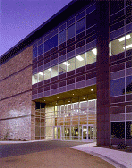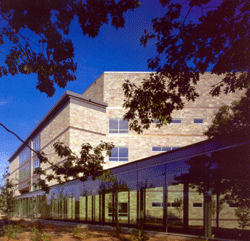Ceridian Headquarters Blends Copper With Other Natural Materials for Lasting Beauty
Copper Applications in Architecture
The Architectural Design Program
| The Site | The Design | Natural Weathering | Other Uses | Benefits | The Structures | The Views | Space Organization | The Ceridian Corporation Headquarters BuildingThe Architectural Design Program 
In developing the design program for the new headquarters building, Loren Ahles, principal and project architect, Ceridian and Kara Hill, project designer of the firm of Hammel, Green and Abrahamson, Inc. (HGA), worked closely with a project team from Ceridian to produce a building complex that would be guided by two principles: first, to respond harmoniously to the strong qualities of the natural site, and second, to develop a work place appropriate for the organization's current and evolving culture.
The Site 
The site selected for the project lays along the northern bluff of the Minnesota River south of downtown Minneapolis and the Minneapolis/St Paul International Airport. The site contains mature bluff vegetation including a stand of old oak savannah. The mandate to the design team was to preserve the intrinsic beauty of the site by allowing the structures to blend with the topography and vegetation of the existing bluff landscape.
The Design 
The principal exterior materials: copper and limestone, selected for their natural characteristics, are honest and warm. The seam-faced, coursed, Wisconsin Chilton limestone with subtle veins of maroon, rust and green cloaks the north core façades in a rough, weathered surface. The naturally weathering copper, with its ever-changing personality, together with clear glass, wraps the work place façades from stair to stair (Figure 1). The exterior spandrel panel modulation is repeated in the atrium interior as natural finish, cherry wood panels (Figure 2).
 Figure 1. Copper, together with clear glass, wraps the work place facade from stair to stair.
Figure 1. Copper, together with clear glass, wraps the work place facade from stair to stair.
Figure 2. In the atrium interior, decorative copper accents natural cherry wood
Natural Weathering 
 Figure 3. Two years after construction was completed, teh process of protective patina formation. In time, the red shades will give way to browns, and, eventually, gray-green.
Figure 3. Two years after construction was completed, teh process of protective patina formation. In time, the red shades will give way to browns, and, eventually, gray-green.From the inception of the design program, the architects' intention was to permit the copper spandrels and the other exterior copper elements to weather naturally. No consideration was given to preserving the mirror bright copper finish through the application of a clear organic coating. A highly reflective finish was deemed undesirable. By permitting the exterior copper faced elements to weather naturally, the architects minimized maintenance, instead relying on rainfall to flush accumulated dust from exposed surfaces while fostering continuing, subtle, transitional color changes throughout the useful service life of the building. Working closely with Ceridian's building project committee, they made a concerted effort to convey to corporate management an understanding and appreciation of the fact that, once installed, the bright factory finish look of the copper spandrels would quickly give way to a somewhat mottled mix of iridescent pink, yellow, orange and blue hues as the initial oxide film formed on the copper surfaces. Then, within a few months as the oxide film thickened, the copper would display a more uniform gold-bronze hue, with some color variations occurring on the vertical, horizontal and sloped positions of the spandrel surfaces as well as from runoff from adjacent materials, such as elements of the aluminum curtain wall and the window glass (Figure 3).
The architects explained that in this region, and over a period of years, the natural weathering cycle would further alter the surface color of the copper from a relatively dark brown to and through a flint gray stage to the ultimate gray-green patina. Horizontal surfaces that retain moisture the longest would tend to pass through the various stages at a faster pace than sloping surfaces with vertical surfaces the slowest to change. Subtle color variations would also occur as a result of moisture migration from adjacent materials.
Other Uses 

Figure 4. Main enterance at the building's north elevation. Both copper-faced and aluminum spandrel panels are used in the aluminum framed curtain wall above the entrance.
While the profiled copper spandrel panels on the Ceridian Headquarters Building are not an integral part of the building's weather-resisting envelope, there is no compelling reason why they could not be incorporated as functional elements of a curtain wall system such as that which the architects created for the Ceridian building's main entrance (Figure4). Other exterior uses include: roofing, column covers, cornices (See "Flat: New Look for Copper Architectural Panels") and fascias. Interior end uses could include column covers, wall cladding, display cases, decorative screens and furniture.
Benefits 
Had the brass spandrel panels on the Seagram Building been laminated copper composites of the type used on the Ceridian Corporation headquarters building, the weight per panel would have decreased from 72 lb to about 27 lb (33 kg to 12 kg), or from roughly 5.5-2.1lb/sq ft (27-10.2 kg/sq m).
In the case of General Electric's World's Fair Pavilion, panel weights per square foot would have been on a par, but the larger available sizes of the Alpolic composite panels would have reduced both installation time and cost significantly. And in both instances, the metal panels would have been as flat as any architect might have wanted them to be.
The Structures 
 Figure 5. The entry/crossroad building volume between two wings provides a communal window to the river valley below.
Figure 5. The entry/crossroad building volume between two wings provides a communal window to the river valley below.The building's orientation on the site takes particular advantage of the dramatic river views. The building's east wing parallels the bluff's contour while the west wing projects on piers into the forest's overstory, thus maximizing workplace views. The volume between the two wings forms the entry/crossroads of the building plan and provides a communal window to the river valley beyond (Figure 5). The 210,000 sq ft (19,510 sq m) of required work place area occupies five levels, the lowest of which is stepped into the side of the bluff.
A remote, four-level, ramped parking structure constructed partially below grade in order to minimize its bulk is located at the northwest corner of the site west of the main building. A glass-enclosed, temperature-controlled walkway connects the two structures (Figure 6 ).

Figure 6. A glass-enclosed, temperature controlled walkway links the remonte, ramped, parking structure to the main entry lobby of the building.
The Views 
Views of and from the bluff determined the open curtain wall design used for the east, south and west façades. Conference rooms, activities rooms, storage rooms, rest rooms and similar enclosed spaces with controlled views are located along the north façade where they buffer the large, open office areas from the prevailing winter winds and from airport traffic noise. Tall ceilings and ample glass area allow natural light to penetrate to the center of the work areas on each floor (Figure 7 ). Louvered aluminum sunshades at the four upper levels on the south façade, as well as a deep overhang at the lowest level, limit direct entry of sunlight to the interior work areas immediately adjacent to the window wall between late spring and early fall (Figure 8 ).
 Figure 7. Tall windows and ample glass areas permit natural light to penetrate to the center of the work area on each floor. |
 Figure 8. Fixed, louvered sunshades project from the building's south elevation at the four upper stories. |
Space Organization 
Organization of the work areas, with their open and well-articulated circulation patterns, enhances the sense of community and interaction required by workers of a modem information company. The building's three principal stairways are open to facilitate movement and to provide direct views of the site and the river valley beyond (Figure 9).
 Figure 9. The building's west wing projects on piers into the forest's ovestory,thus maximizing workplace views.
Figure 9. The building's west wing projects on piers into the forest's ovestory,thus maximizing workplace views.The Ceridian Corporation Headquarters Building 
Location: 3311 East Old Shakopee Road, Bloomington, Minnesota
Owner/Developer: Ceridian Corporation, an information services company serving businesses and employees in the United States, Canada and the United Kingdom. Ceridian offers a broad range of human resource services including: outsourcing, payroll, benefits administration, tax compliance, HR information systems and employee advisory programs. For additional information, visit Ceridian.
Architects: Hammel, Green and Abrahamson, Inc. (HGA), Minneapolis, Minnesota
General Contractor: McGough Construction Company, Inc., St. Paul, Minnesota
Curtainwall Fabricator/Erector: Hannon, Inc., Golden Valley, Minnesota
Copper Spandrel Panels Fabricator: Metal Specialty Systems, Incorporated, Lakeville, Minnesota
Copper Faced Composite Panels Manufacturer: Mitsubishi Chemical America, Inc.; Alpolic Composite Materials Division, Chesapeake, Virginia.
Also in this Issue:
- Ceridian Headquarters Blends Copper With Other Natural Materials for Lasting Beauty
- Flat: New Look for Copper Architecture Panels
